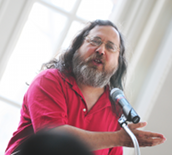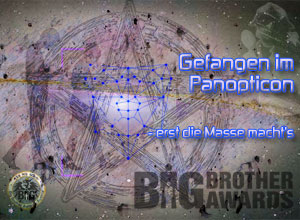

|
search / subscribe / upload / contact |
|
|
||
|
|
||
|
|
||
|
|
||
|
|
||
|
|
||
|
|
||
|
|
||
| RSS-Feed Depeschen | ||

|
||
Date: 2001-12-06
US: Der taegliche Horror der Cops-.-. --.- -.-. --.- -.-. --.- -.-. --.- -.-. --.- -.-. --.- wohl reichlich unverdächtig ist, werden die Grenzen der Gesichtserkennung durch Kameras aufgezeigt: Nettes Tool zur Vorauswahl, aber keine Wunder - Sowas aber auch. 2. Die NYT berichtet, dass Palm Springs/Calif. bereits die Palmen verdrahtet, um 24/7-Kameras aufzuhängen. Und in Virginia Beach wird schon fleißig gescannt - mit extrem gestiegener Zustimmung der Bewohner, aber typischen Datenbank-Troubles: Bei der Distribution der Watch-List-Databases scheint es holprige bis unpassierbare Amtswege zu geben. Ergebnis: Vollgas im Leerlauf - Alles sehen, aber nichts erkennen. 3. In Tampa/Florida, der ersten Us-Stadt mit Totalüberwachung, scannen die Kameras bis zu 100 Gesichter pro Minute. Das seit sechs Monaten, aber ohne dass das System bisher auch nur zu einer einzigen Verhaftung beigetragen hätte. 4. Aus Virginia Beach verlautete es: "I think we now think of it less like Big Brother and more like a little friend". Das kleine Früchtchen dürfte auch noch einen großen Bruder haben: Die auf der Website des 'Law and Order Magazines' gelisteten Links zu "Anti-Police-Sites" sind mit heutigem Stand alle tot. Tja, kann passieren. -.-. --.- -.-. --.- -.-. --.- -.-. --.- -.-. --.- -.-. --.- "Face Recognition Technology" (by Matthew Grinnell (grad student) and Tod Burke - [email protected] (former Maryland state pig) Face recognition technology analyzes contours and bone structures of the face and converts it into a code or number. A data base is then searched to see if the code matches a know criminal or person. The key to the FACETRACE technology is a "good frontal shot of the face with both eyes shown" Another issue concerning face recognition is the ability of individuals to deceive the camera by using sunglasses, wearing hats, growing facial hair, etc. According to Dan Blackburn, "if sunglasses actually hide the eyes, identification is made more difficult." he did indicate that as long as the sunglasses do not totally conceal the eyes, identification is possible. the same is true for hats and facial hair. (so criminals and fugitives hide your eyes with the biggest and blackest sunglasses you can find! even at night time) Research revealed that the likelihood of finding the correct person is about 99% with a camera angle of 15-25 degrees. the probability drops to 88% for a 40 degree camera angle, and 58% for a 60 degree camera angle. (privacy seekers keep as far away from the camera as you can) As expected the shorter the distance between the subject and the camera the greater the accuracy. The lighting must be good enough to see the face clearly, without significant shadowing. One use of face recognition technology is using it to decide who to question. At a border crossing the government has a data base of know drug traffickers and pictures of people crossing the border are compared for matches. those that match are questioned. or it could be a government roadblock or checkpoint. (so if the government has your photo and wants to talk to you keep away from the cameras) useful URL's http://www.visionics.com http://www.printrakinternational.com http://www.imagis-cascade.com http://www.graphcotech.com http://www.iwsinc.com phone numbers of companies that make this equipment: visionics corp (201)332-9213 graphco technologies inc (215)497-9170 imagis technologies inc (604)684-2449 imageware systems inc (858)673-8600 printrak international (714)238-2000 Volltext Law and Order Magazine: http://www.lawandordermag.com/index2.html -.-. --.- -.-. --.- -.-. --.- -.-. --.- -.-. --.- -.-. --.- New York Times December 6, 2001 SECURITY ISSUES Electronic Surveillance: From 'Big Brother' Fears to Safety Tool (By TIMOTHY EGAN) PALM SPRINGS, Calif., Dec. 5 They are getting ready to wire up the palm trees in this desert resort, putting electronic eyes 24-7 on the main business street. On the other side of the country, Virginia Beach has decided to install outdoor cameras on its main boardwalk. The cameras will scan the faces of people at random, crosschecking them with faces of criminals stored in a computer database. Before Sept. 11, the idea that Americans would submit to round-the-clock electronic surveillance on streets and public walkways seemed remote. Only six months ago, after Tampa, Fla., became the first city in the country to install face recognition cameras for routine surveillance, it set off loud protests. People wearing Groucho Marx glasses to defy the cameras joined conservative social critics in decrying a new era of optical omniscience. But now some people who once thought surveillance cameras were inconsistent with the values of an open society have tentatively embraced them. "I was really struggling with this," said Mayor Meyera Oberndorf of Virginia Beach. "But people are feeling so unsettled since 9/11 that they wanted this. They kept saying, `How can you deny us a tool that will keep us safe?' " Here in Palm Springs, the desert oasis that draws tourists and snowbirds, about half the people who contacted the city during its surveillance camera debate opposed their installation. Now the opposition has all but disappeared, said David H. Ready, the city manager. "I think we now think of it less like Big Brother and more like a little friend," Mr. Ready said. "Since the terrorist attacks, I haven't heard a peep of opposition." But some elected officials and people in law enforcement caution that surveillance cameras have not proved effective in catching fugitives or terrorists and that they raise a host of unresolved legal questions. "I don't think people realize how much this is going to change our lives," said Reba McClanan, the only Virginia Beach City Council member who voted against installing cameras. "While everyone wants to do something after the Sept. 11 attacks, my concern is that in the rush to do something, we have created something we may ultimately regret." In Tampa, a system that scans up to 100 faces a minute looking for fugitives or other wanted individuals has not enabled the police to make a single arrest. "The idea of putting these systems up on Main Street, U.S.A., is not only bad policy, it's bad law enforcement," said Kevin Watson, a spokesman for the Law Enforcement Alliance of America, which represents about 65,000 active and retired police officers, and crime victims. "Here you have a tool that takes police officers out of the community and makes them look like a pawn of Big Brother." There are two general types of surveillance systems. One is face recognition technology used in Tampa and soon to be installed in Virginia Beach which scans faces for 80 different unique aspects and then matches them to a database of stored images. Shortly after the attacks, Howard Safir, the former police commissioner of New York, recommended the installation of 100 such cameras in Times Square. The other method is more common, a closed-circuit television system that can continuously monitor certain areas, storing video images for a given period of time, depending on prevailing legal standards. More than two million of these cameras are installed in the United States, according to the Security Industry Association, though most of them are in enclosed spaces such as malls, airports and parking garages. Most recently, Boulder City, Nev., a suburb of Las Vegas has made plans to install surveillance cameras looking at parks and intersections. The leading company in promoting face recognition cameras, the Visionics Corporation of Jersey City, will provide the technology for Virginia Beach. It also supplies recognition software to Tampa and to cities in England, where surveillance cameras are widely used. The company promotes its system as one that protects privacy of law- abiding citizens. If a person is not in the database of wanted individuals, the facial image is not stored. "This is not a national ID card," said Dr. Joseph Atick, the founder and chairman of Visionics. "This is a tool. What is does is add a set of eyes, which you can use to enhance human intelligence gathering." Since Sept. 11, the company's stock price has tripled. "We have a lot of orders," Mr. Atick said. Questions about whose faces will be stored in the database, and who will have access to those images, have not been settled by courts or governments. In Virginia Beach, public sentiment turned in favor of the system after reports circulated that at least two of the 19 hijackers from the World Trade Center and Pentagon attacks had spent time in the area. But it is unclear how much good such a system would do. Even though some of the hijackers were on a Federal Bureau of Investigation watch list, none of their images were part of the database of 30,000 or so images stored in Tampa's system. Virginia Beach would not automatically get the watch list, either the data can be obtained only with the permission of the F.B.I. "Virginia Beach is just a case of nonsense," said Mr. Watson of the law enforcement alliance. "Here they are acting out of fear, taking a system that hasn't caught a single person and would not have picked up those terrorists." In Tampa, Detective Bill Todd, who oversees the face recognition cameras, said the city was discussing whether to enter people from the F.B.I. watch list into its database. Most of the people currently in the system are fugitives or are wanted for misdemeanor warrants, he said. The system backfired earlier this year when the police were demonstrating it to reporters. One image of a man was photographed and reprinted in a magazine. A woman in Texas who saw the image claimed the man in the picture was wanted for crimes. She called the Tampa police, who questioned the man, a construction worker. It was the wrong person, the police said. "The system is pretty accurate, but it's not 100 percent accurate," Detective Todd said. As in Virginia Beach, Palm Springs is a relatively low crime area. But starting early next year, cameras will line Palm Canyon Drive, a promenade with a minor Walk of Fame (Monty Hall and Trini Lopez are among those whose names are embedded in the sidewalk). "I don't really consider downtown Palm Springs or any streetscape to be a private area," said Chris Mills, a new City Council member who just defeated an incumbent who opposed the cameras. "I view this as a mall, and any mall in America these days has a lot of cameras." On Palm Canyon Drive, most merchants supported the cameras as well. "The way I look at it is, if you're a criminal, you got something to worry about, but if you're you or me, what difference does it make?" said Stuart Peterson, who runs a jewelry shop on Palm Canyon. "It's not like it's going to be used to pick up somebody walking down the street with another guy's wife." But Ron Oden, one of two Council members on the five-member body to oppose cameras, said having a roaming eye on the street opened the city to random spying. "I just don't think it's in the government's best interest to be watching everyday people," Mr. Oden said. Volltext: http://www.nytimes.com/2001/12/06/national/06SURV.html?pagewanted=print -.-. --.- -.-. --.- -.-. --.- -.-. --.- -.-. --.- -.-. --.- relayed by: [email protected] Thnx to: Georg Schoefbaenker <[email protected]> Thnx to: g'o'tz ohnesorge <[email protected]> -.-. --.- -.-. --.- -.-. --.- -.-. --.- -.-. --.- -.-. --.- -.-. --.- -.-. --.- -.-. --.- -.-. --.- -.-. --.- - -.-. --.- -.-. --.- -.-. --.- -.-. --.- -.-. --.- -.-. --.- edited by Harkank published on: 2001-12-06 comments to [email protected] subscribe Newsletter - -.-. --.- -.-. --.- -.-. --.- -.-. --.- -.-. --.- -.-. --.- |
|
|
|
| related topiqs | |
| CURRENTLY RUNNING | |
q/Talk 1.Juli: The Danger of Software Users Don't Control

|
|
| !WATCH OUT! | |
bits4free 14.Juli 2011: OpenStreetMap Erfinder Steve Coast live in Wien

|
|

